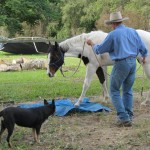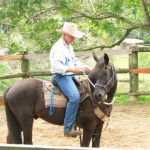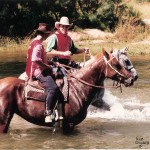By Gavin Bartlett
One of the biggest things I come across in my clinics and helping people is a genuine fear that some people have when it comes to riding. And being nervous while riding can create all sorts of problems and issues itself. For some horses it’s not enough that they are afraid that they might get eaten by nearly every object that they see, or from whatever may be hiding in the bush or behind every tree or rock, but when their rider feels anxious they feel they need to take over.
So what can we do about being scared of getting on our horse. For me this is a process. It takes time, and a little bit of dedication from the people I’m working with, to progress to where they are confident to ride out and not feel like they have to jump off at the first sign of nervousness from their horse.
Embrace Your Fear
The first thing I like people to understand, is not to negate their fear. A lot of well meaning friends and people will give you the line to just suck it up. Push through your fear. There’s nothing to be afraid of. I have some very great reservations about this kind of mindset. I see it as counter-productive at best, and at it’s worst – dangerous. Fear is natures way of keeping us alive. It’s here for a reason. It’s helped life for in all animals for millions of years.
 By working on all kinds of objects you build confidence in your horse for all kinds of situations.
By working on all kinds of objects you build confidence in your horse for all kinds of situations.
I prefer to use the fear. Not negate it. Acknowledge that you are scared. Denying that you are in a situation that is totally freaking you out only makes the problem worse, because you keep focussed on the problem and not on how you can rectify it. So instead of trying to forget that you’re fearful, or that you’re not scared, admit that you are. And strangely enough, this will take the pressure off. Not just you, but also your horse.
Next is to embrace your fear. What do I mean by that? Find out exactly what it is that you’re afraid of. You can try asking your fear what it is trying to tell you. Picture that fear as if it is a person standing in front of you and ask it why it’s here. Give it a name even. Does it have a message for you. What is the purpose of it. Once you know why you are afraid of something it becomes much easier to deal with it. Then appreciate it. You can actually be grateful for the fear.
Change Your Thought Process
Once you change the way you look at your fear, you can begin to develop some confidence around it. This starts with the way you think. This goes hand in hand with being scared. As I said earlier, you don’t want to negate the fear you have. You want to use it to your advantage. Tell yourself that you can handle it. That one line has helped me so much over the years. “I Can Handle It!”. It doesn’t mean you don’t have to be scared or afraid of riding your horse. Quite the opposite. It gives you something more constructive you can focus on.
An inspirational speaker I know, Dr John Demartini, says that fear is a future projection that we will experience more pain than pleasure, more loss than gain, more challenge than support. He suggests that we need to equilibrate our brain process so we can be more clear and focussed. An exercise that he recommends for is to think of at least 30 to 50 benefits of our fear. Sounds a little strange, but when done properly, this can have a dramatic shift in the way we go about overcoming the situation. As an example, some benefits might be that our fear keeps us sharp, prevents us getting complacent, gets us to focus more directly.
 Just sitting on your horse can build your confidence and your horses as well.
Just sitting on your horse can build your confidence and your horses as well.
You can also give yourself an affirmation or a mantra to say to yourself. I like to use the phrase FEEL, TIMING and BALANCE. When I’m in a situation that I’m having trouble with, I repeat this line over and over to myself. It helps me to remember some of the fundamental principles of what I’m doing at that very moment.
Another technique that I’ve found useful is to go back in your mind to a time you were in a situation and you dealt with it confidently and effectively. Think of a time where you were confident and relaxed. Picture yourself in that moment. Feel what that confidence is like. See yourself overcoming that event or situation. Could you sense any fear? How did you work through it?
Breathe and Relax
The next thing to remember is to breathe and relax. When we get scared we tend to hold our breath. This creates tension in our body, and primes our horse to react even more. We need to think about changing our physiology, and to that we need to start breathing. When you find yourself in a spot with your horse, breathe, count out each breath for ten breaths, and breathe right down to your feet. Breathe deep. If you don’t feel much of a change, take another ten breaths. And keep going until you feel yourself start to relax. Whenever you tense up, that becomes a direct message to your horse that you have lost all confidence. So he takes over. He says “I’m scared, so I’m getting ready to get out of here. And now you’re scared too, so I better take leadership, look around more, because I need to get you out of danger too”.
The Myth of the Comfort Zone
You will often hear people talk about The Comfort Zone. Some bubble that you have to step out of to build your confidence and so on and so forth. I find this very confusing for people to understand. It implies that you always have control of every situation and that you can come and go into and out this place as you please. When it comes to horses, you don’t always get that choice. Confidence is built by a number of really neat things.
Confront small fears, bit by bit. For a really scared person it might be by going up and rubbing a horse on the nose. Then you might rub him down the neck. And so on. As you start to do a little more, you build your confidence. Bit by bit.
 Having confidence in yourself allows you to take on bigger challenges. And helps your horse in these places as well.
Having confidence in yourself allows you to take on bigger challenges. And helps your horse in these places as well.
Build your skills. As you learn how to do a particular activity with your horse, you build confidence. The more skills you have, the more tools you have to get out of and overcome situations.
Build your knowledge. This goes hand in hand with building your skills. The more you learn about and the more knowledge you have the more you can do about it. Read some books. Find a good instructor.
Build Your Horses Skills and Confidence
Groundwork is a really great way to build not just your confidence, but it’s great for your horse. Pretty much everything I do when I’m starting a horse is for this outcome. It builds a reliable, safe mount when you ride, a horse that is confident and can deal with many situations, he is better to ride, less spooky, he moves better, more freely, and more effectively and efficiently. He knows what to do in different situations, and he becomes lighter and softer.
The basic exercises that I like to do on the ground to start with are:
- bringing the head down
- lateral flexion
- vertical flexion
- backing your horse
- stepping the hind end over
- stopping lightly and softly.
These exercises I like to do to bring in lightness and softness and to have my horse working properly. Once I have these ones I move on to crossing poles, standing on tarps, walking through stacks of tyres, crossing bridges and teeter totters (see-saws) and as many things I can think of. These are just a few of the things I get to doing with people in my clinics and when I’m starting and handling horses.
So with just a few little changes in the way we look at how we feel about our fear, we can begin to build the confidence we need to ride our horse with ease and grace, and a feeling that we can get through our riding day safe – or at least safer. This will give you the ability to have more of an idea or to know what to do in a situation so that it starts to become more automatic and more like second nature. When it gets to being like that, riding is more enjoyable, much more fun, and your horse has a better time too.
Gavin Bartlett
Read more about the Author here

